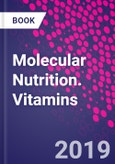Molecular Nutrition: Vitamins presents the nutritional and molecular aspects of vitamins with a specific focus on vitamins A, B1 (thiamine), B2 (riboflavin), B# (niacin), B5 (pantothenic acid), B6, (pyridoxine), B7 (biotin), B9 (folate), B12 (colbamin), C, D, E, and K. As part of the Molecular Nutrition series, this book discusses introductory aspects and general coverage of vitamins and nutrition, the molecular biology of the cell, including signaling, transporters, oxidative stress, receptors, uptake, immunity, proliferation, endoplasmic reticulum, differentiation, carcinogenesis and apoptosis. Final sections cover genetic machinery and its function, transcriptional processes, homeostasis genes, cancer, gene expression, mutations, and more.
Emerging fields of molecular biology and important discoveries related to diet and nutritional health are also covered, rounding out the book.
Please Note: This is an On Demand product, delivery may take up to 11 working days after payment has been received.
Table of Contents
I General and Introductory Aspects 1. Vitamin E: An Overview 2. Requirements for Vitamins in Different Stages of the Life Cycle 3. Vitamin C: Metabolism, Epigenetic Roles, and Cancer 4. Riboflavin and Health: A Review 5. A Review of Vitamin B12II Molecular Biology of the Cell 6. Vitamin D Receptor in Arterial Ageing 7. Tocotrienol Regulation of AMPK in Cancer 8. Niacin and Hyperlipidemia 9. Folate Transporters in Placentas 10. Linking B-vitamins, Choline, and Stroke 11. Riboflavin (Vitamin B2) and Mitochondrial Energy 12. Pantothenic Acid (Vitamin B5) - Immunoreactive Neurons 13. Ascorbic Acid (Vitamin C) and Alzheimer's Disease 14. Vitamin B1 and the Pyruvate Dehydrogenase Complex 15. Vitamin D and Diabetes Mellitus: Vitamin D Metabolism, Alterations of Vitamin D Endo-paracrine System and their Relation to Oxidative/Nitrosative Stress, Inflammation, and Cell survival 16. Grape Seed Extract and Pyridoxine (Vitamin B6) 17. Cobalamin (Vitamin B12) Malabsorption 18. Pyridoxine (Vitamin B6) and Selenium Interactions: Implications for Human Health 19. Linking Vitamin E and Nitric Oxide in Liver Disease 20. Use of Methylcobalamin (Vitamin B12) in Pain 21. New Properties of Vitamin B6 or Pyridoxine in Experimental Oxidative Stress in the Brain 22. Thiamine (B1), Oxidative Stress, and Ethanol 23. Vitamin E: Novel Metabolites and Treatments 24. Vitamin E Structure and Forms/Analytical Methods 25. Pyruvate Carboxylase (PC) and the Biotin Carboxylase Domain 26. Application of Vitamins 27. Vitamins in Chronic Kidney Disease 28. Inflammatory Bowel Disorders and Fat-soluble Vitamins 29. Vitamin E and Reproductive Health 30. Vitamin B12 and Diabetes 31. Biotin Status Screening 32. Prostate Cancer and Applications of Vitamin K 33. Non-alcoholic Fatty Liver Disease and Use of Folate 34. Scenarios of Low Vitamin K Intakes
III Genetic Machinery and its Function 35. Transcriptional Control of Cells by Vitamin D 36. Transcriptome Analysis for Vitamin B3 (Niacin) and its Receptor GPR109A 37. Novel preventive mechanisms of vitamin B6 against inflammation, inflammasome, and chronic diseases 38. Vitamins and Epigenetics








